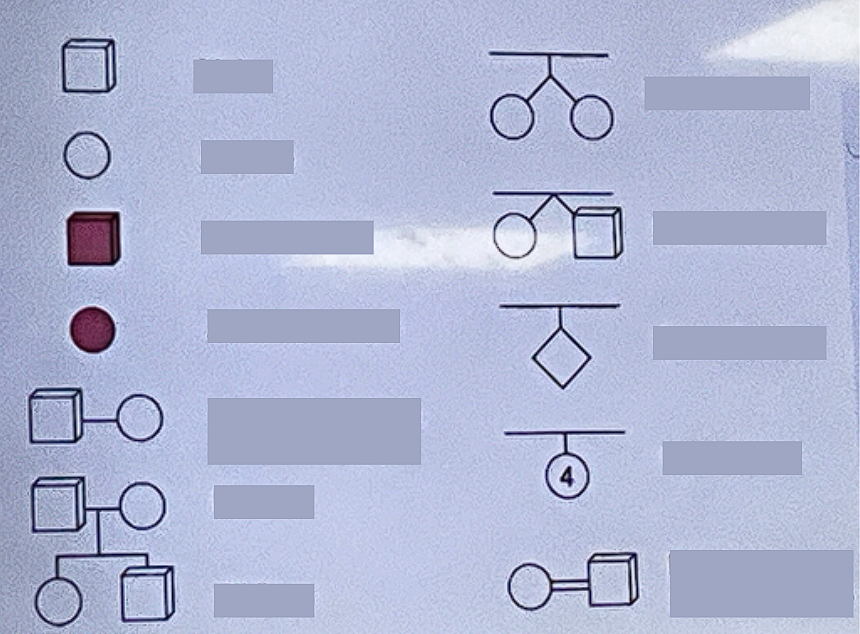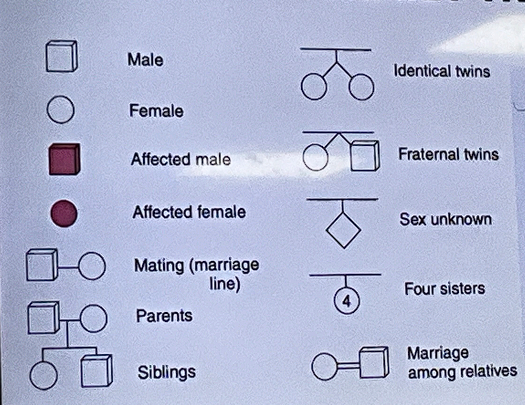Pedigree Part 1
1/26
There's no tags or description
Looks like no tags are added yet.
Name | Mastery | Learn | Test | Matching | Spaced |
|---|
No study sessions yet.
27 Terms
• Record of the family of an individual
• Can be used to study the transmission of a hereditary condition
PEDIGREE ANALYSIS
• Useful in large families
• Shows traits over several generations
PEDIGREE ANALYSIS
Normal appearance of genetically controlled traits in the phenotype.
Penetrance
The degree of expression of a genetically controlled trait.
Expressivity
Determines whether the gene is expressed or not.
Penetrance
Determines how much the trait affects or how many features of the trait appear in person.
Expressivity
When 100% of individuals with the genotype express the associated trait.
Complete Penetrance
When some individuals with the genotype do not show the expected phenotype. (50%)
Incomplete Penetrance
When all individuals with the genotype show the trait to the same degree.
Constant Expressivity
When individuals with the same genotype show the phenotype with different severity or forms.
Variable Expressivity
• A phenotype not genetically determined but looks like a genetically controlled phenotype
• Environmental exposure
Phenocopy
What are situations that show Phenocopy?
• Thalidomide exposure causes phocomelia
• Gestational Zika virus infection in the mother may cause microcephaly
Under Family Tree what does the Following mean?
Shapes
• Squares:
• Circle:
Shapes
• Squares: males
• Circle: females
Under Family Tree what does the Following mean?
Lines
• Horizontal:
• Vertical:
• Diagonal:
Lines
• Horizontal: marriage
• Vertical: offspring
• Diagonal: death
Under Family Tree what does the Following mean?
Filling
• Shaded:
• Partially shaded:
• No shade:
Filling
• Shaded: with trait
• Partially shaded: carrier
• No shade: without trait
Under Family Tree what does the Following mean?
Numbers
• Roman numerals:
• Numbers:
Numbers
• Roman numerals: generations
• Numbers: birth order


1. Every affected child has an affected parent; no generations are skipped
2. Trait occurs about equally in both sexes
3. When an affected person mates with an unaffected person, approximately 50% of their offspring should be affected
Autosomal Dominant Inheritance
Examples of Autosomal Dominant Inheritance
• Polydactyly
• Huntington disease
• Neurofibromatosis
• Polycystic kidney disease
• Progeria
1. Traits often skip generations
2. Trait occurs about equally in both sexes
Autosomal Recessive Inheritance
3. Commonly seen in consanguineous matings.
4. If both parents are affected, all children should be affected.
Autosomal Recessive Inheritance
5. When an affected person mates with an unaffected person, all offspring are unaffected.
6. Most affected individuals have unaffected parents.
Autosomal Recessive Inheritance
Examples of Autosomal Recessive Inheritance
• Cystic fibrosis
• Sickle cell anemia
• Tay-sachs disease
1. Traits does not skip generations
2. Affected males result from affected mothers.
3. Approx. half the children of an affected heterozygous female are affected.
Sex-linked Dominant Inheritance
4. Affected females come from affected mothers/fathers.
5. All the daughters but none of the sons of an affected father are affected.
Sex-linked Dominant Inheritance
1. Traits may skip generations
2. Most affected individuals are male.
3. Affected males result from affected/carrier mothers.
4. Affected females come from affected fathers and affected/carrier mothers.
Sex-linked Recessive Inheritance
5. Sons of affected females should be affected.
6. Approximately half the sons of carrier females should be affected.
Sex-linked Recessive Inheritance